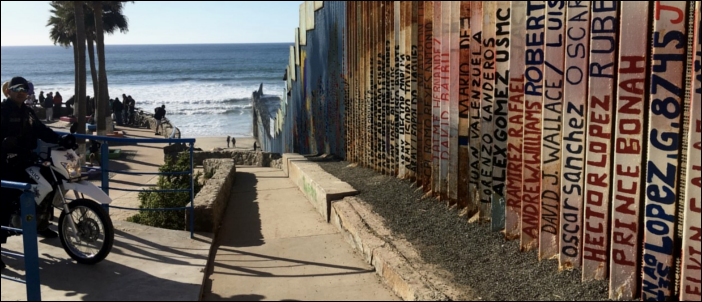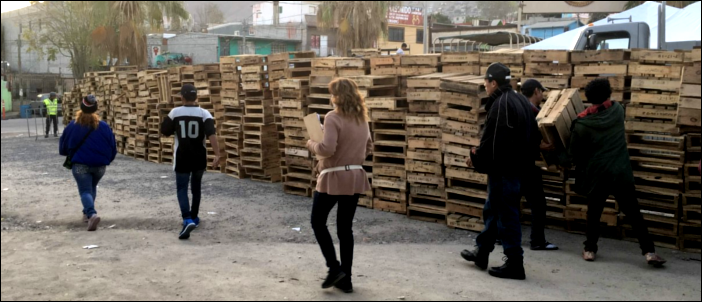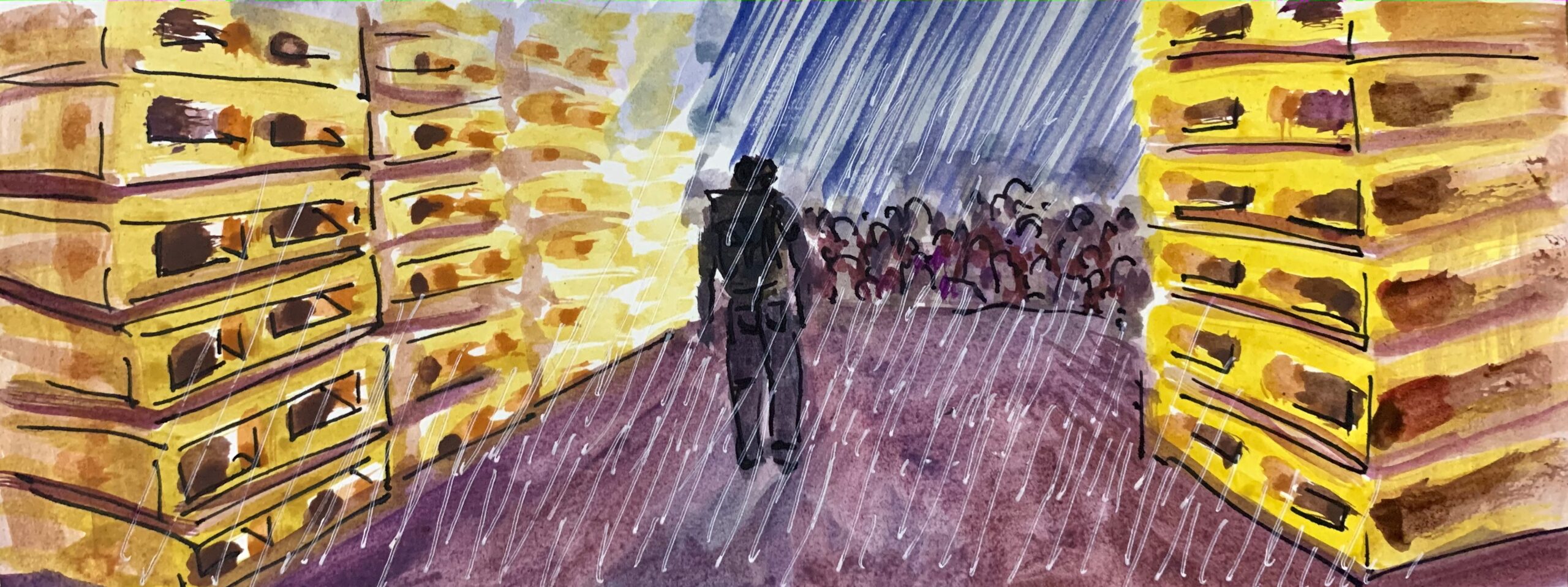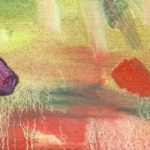Moises Hernandez studies gender and digital theory at Southern Methodist University in Dallas, Texas.
In late November 2018, as I finished my bachelor’s, I heard news about migrant travelers making their way toward the U.S. border from Central America. With my background in Mexican-American Studies, I was familiar with such history and its misconceptions, and I foresaw a complicated narrative developing online in the coming weeks.
By November 15, after trekking nearly 2,500 miles, the Migrant Caravan reached the border town of Tijuana. The Mexican government collected and housed the remaining 5,000 migrants at Tijuana Stadium to be kept safe until further processing. Mind that this structure was designed to hold only 3,000.
My generation, one of keyboard-warriors and virtual-activists, mean well, but it’s easy to take the conveniences of technology for granted. When concerned individuals learn about an event such as this diaspora, they often follow up with re-tweets or possibly donations. They rarely experience the crisis for themselves.
Instead of retweeting the plights of the migrants, I wanted to experience this world and see how I could help.
In December 2018, I flew to Tijuana, Mexico, to lend a hand.
I brought only a handful of items: state-issued ID, passport, phone charger, spare t-shirt, and cash. After a bus ride, a trolley, and a short walk, my passport was stamped. By noon, I found myself moving toward two metal swivel gates with razor-wire fences on either side, above me were large metal letters reading “Mexico.”
A barrage of drivers greeted me, and I had little difficulty finding a ride to my first stop: La Monumental (the Monument).
La Monumental was a site for concerts on the weekends. Located at the northwestern point of Tijuana, where the U.S. and Mexico trade waters, La Monumental would have been a logical spot for Mexican authorities to house the rumored migrant camps. Unfortunately, upon arrival, there were no crowds, tents, or police officers. It was just a dusty parking lot.
As I approached La Monumental, I got a better view of the rust-colored border wall. Most of the wall was decorated with murals by both Mexican and American artists. The wall ran a few hundred feet past a popular tourist beach before submerging itself into the ocean like a giant metal serpentine beast. A leviathan. I stood at the edge of the beach overlook and scanned the wall. Pressed up against the border wall were two dozen migrant travelers. They looked as if they had been standing in the sand for days. Their arms reached through the gaps of the fence. On the other side of the wall rode border patrol agents on ATVs (all-terrain vehicles), neither paying much attention to nor truly ignoring the migrants. The locals stood around the overlook watching in silence. Some straddled their motorbikes, others sat on the stone wall of the overlook. It seemed as if the migrants had become part of the avenue, another mural to look at.

My watch read 3 pm, so I called for another taxi.
Martín (not his actual name), a young man who didn’t look much older than I, picked me up. Martín asked where I wanted to go, and I confessed that I was a student looking for the migrants. I pointed at the beach. Martín shrugged and said, “They picked them up last week. They moved them to El Barretal.” Located southeast of downtown Tijuana, El Barretal was an hour’s drive through traffic.
During the ride, Martín asked what I was doing, and I replied earnestly: “I came to help.” I should have told him I was there to atone. Atone? Atone for what? Millennial Latino (male) privilege? Was this worth the jet fuel and time? Martín nodded, respecting my response without criticism.
Martín is a father and a full-time taxi driver who spends his time taking tourists around the city. What better way to find the truth than through the eyes and ears of one of Tijuana’s drivers?
So, I asked him his opinion of his migrant neighbors. He smiled and shrugged, “I have no problem with them. They’re here, they’re working. Some people make it hard for them, but I say let them go. Let them work.” We heard someone on the radio bicker excitedly about a Juan Gabriel sighting in Mexico which prompted Martín to turn up the volume and sneer: “Listen to this, I love it! The man’s been dead for years, and they think he’s alive!” After such a smooth segue, I took the hint to drop the conversation and turned my attention toward the bustling traffic around us.
We arrived at 41 Avenida las Torres by 5 pm. Martín slowed the car and pointed at a walled entrance of a nearby complex. I could tell he was concerned since he asked me if I was really sure about getting out of the car. I saw dozens of people, mostly men, idling outside the entrance with half-slung backpacks and bottled drinks. They paid no attention to me. I nodded reassuringly, paid him, and left toward the entrance. Right in front of me was a tall concrete wall with painted advertisements of upcoming shows, all past or canceled. The Mexican soldiers standing by a large gate indicated that I was at the right place. I then noticed several individuals enter a dark entrance and disappear into a corrugated tunnel. I followed them inside, winding through a gated path with signs warning “entrance only, no exit.” No exit. I pressed forward. While I couldn’t see much, I knew that I had finally reached my destination. The thousands of voices that seemed muted on the outside grew louder.
El Barretal was a dancehall-turned-temporary-refugee-camp. Surrounded by dusty abarrotes (tiny grocery shops), the defunct nightclub is found in one of the poorest districts of southeastern Tijuana.
At first, all I saw were tents and vinyl tarps. Then, I saw feet poking out of the zippered flaps and children bouncing around inside. There were hundreds of make-shift shelters and thousands of people moving about.
I saw the walled barriers that kept the migrants in, but I couldn’t make out where the tents ended and the wall began. Then I looked up and saw more. More tents, more people. In a brilliant display of engineering, the migrant travelers had constructed a platform over the original ground floor. Their tents appeared to float in the air, suspended above the ground-level activity.
I kept moving forward. The barricades eventually led me into the main courtyard, and I was surrounded by a living, breathing mini-city. Children played soccer while men washed their own feet on soapy floors. Women exited rudimentary showers, while families lined up at the UNICEF health clinic. There was a tent for dental health, a tent for head-lice, a tent for respiratory illnesses, and a tent for chickenpox. At one corner a man was feeding meals to those who could afford it, while another corner was dedicated as a family zone.
Even with El Barretal about to burst, I knew this couldn’t have been everyone. A UNICEF worker, during an impromptu interview, informed me that over half of the migrants were still scattered throughout Tijuana.
The large gates, once guarded by soldiers, suddenly opened and a truck reversed into El Barretal. On its bed were wooden pallets—a hundred stacked. Dozens of trucks followed. Migrants, volunteers, and soldiers gathered as the tailgates dropped. I pushed my way into the crowd and copied what they did. The crowd reached toward the pallets with open hands. A volunteer lowered a pallet from the top of the truck onto the crowd and watched it float across the sea of hands. Another was grabbed, and the process repeated.
I asked a volunteer, “What is happening, what are the pallets for?” The volunteer, half-annoyed and half-amused, pointed at the sky. Rain was coming. Truckloads of donations from the U.S. may have included weatherproof tents, hygiene products, and warm clothing, but none of that mattered in the face of a sudden downpour. El Barretal was a concrete, roofless space designed for heavy foot traffic, not comfort and not for keeping thousands dry. Pallets were needed to lift the migrants off of their soaking beddings.
Migrants coveted whatever donations they could find, but when the weather and a borderless entity caught up with them they were defenseless. Concerned Americans send care packages and used clothing en masse but most of those items materialized through good-will and passion are rendered moot. They are discarded. What does make it through are the wooden pallets. In that moment those creaky old pallets that existed outside the realm of care and aid were the most valuable things to enter those walls.
There were plenty of splinters and my face caught several elbows, but it was worth it. At that moment, my trip became real. The images of news pundits and liberals barking at each other about what to do was as distant as my wife back home cross-stitching another pattern. We were a silhouette engrossed on one task: move the pallets, keep them dry, move the pallets, keep them dry, move the pallets, keep them dry.

Moises Hernandez studies gender and digital theory at Southern Methodist University in Dallas, Texas.
Art by Michelle Huang. Michelle read this piece and designed an original painting for Conceptions Review. Michelle is an artist from Sugar Land, Texas, now based out of New York, New York. She specializes in oil painting, known for her expressionist style in both figurative and abstract work. Her website is https://mhuangart.com.
Launched in March 2021, Conceptions Review is interested in the ideas people have about society and the consequences of these ideas. We seek accessible and standalone articles about conception-bending ideas and popular misconceptions. We are open to fields ranging from musicology to history to mathematics to insectology and everything in between.


